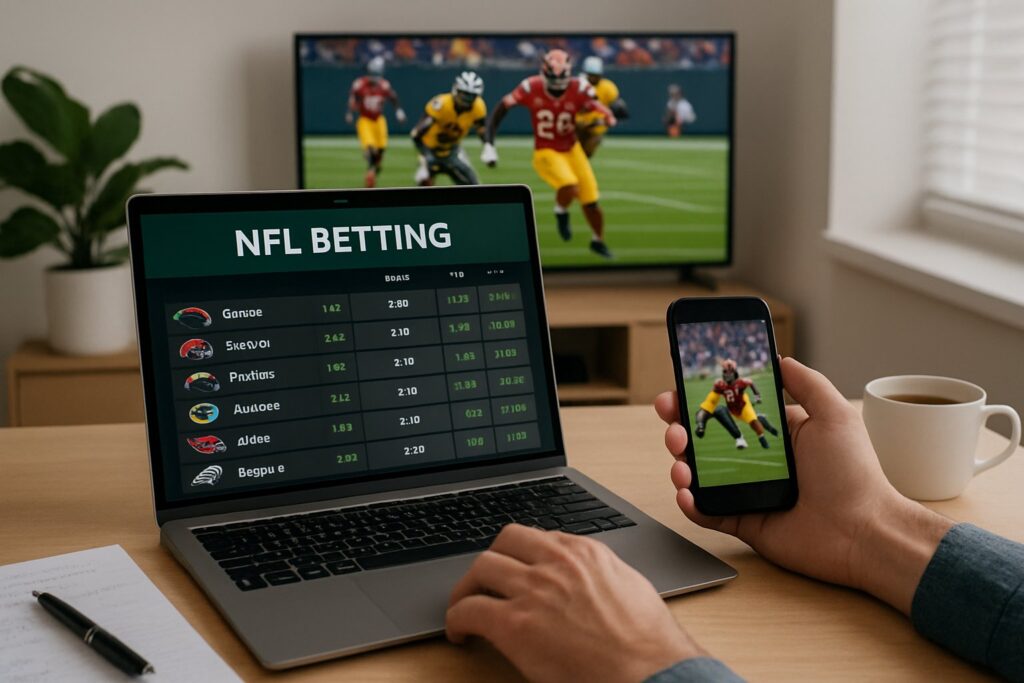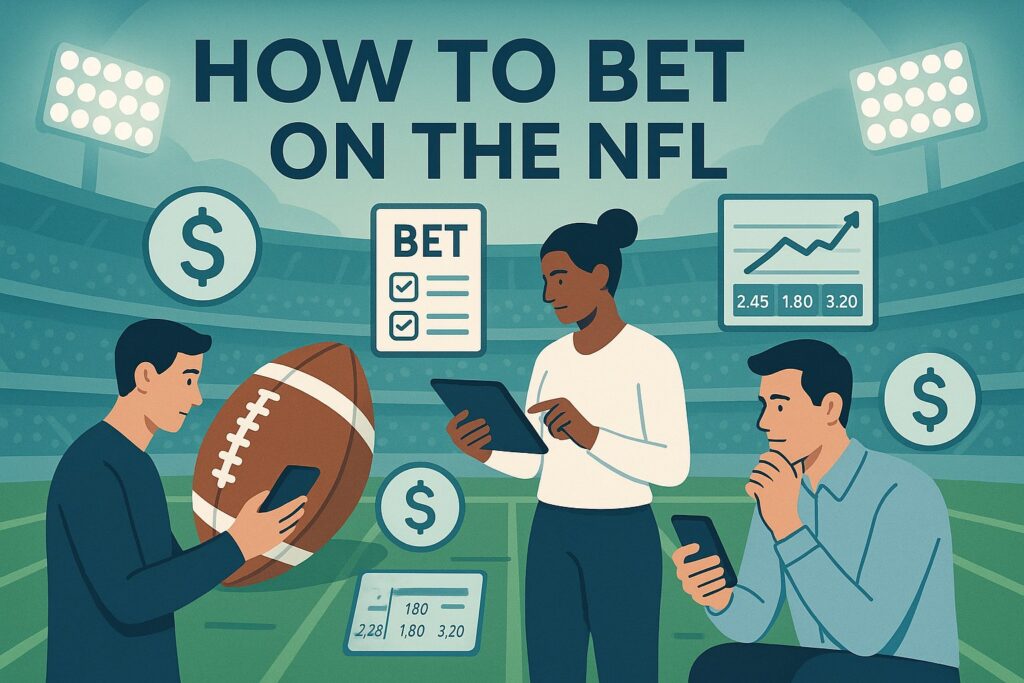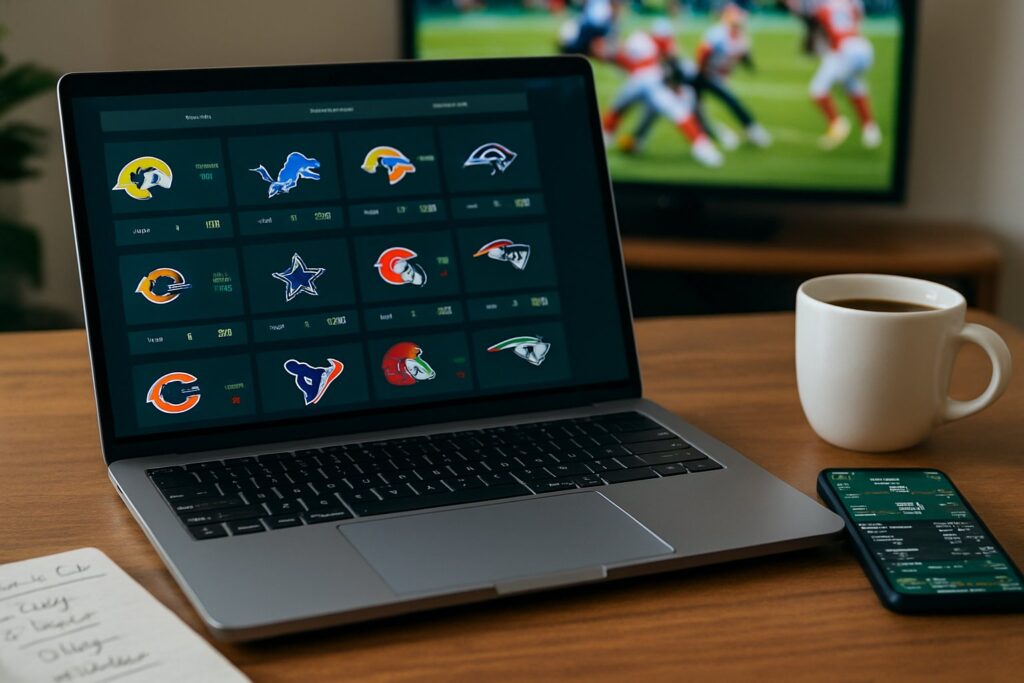by Martin Green
August 9, 2025
Last Updated on August 9, 2025 by Martin Green
Betting on the NFL really starts with the basics. You need to know how odds work, what each type of bet means, and how to manage your bankroll. If you want to bet on the NFL, pick a wager type, understand the odds, and place your bet through a legal sportsbook.

You can bet on a team to win outright, cover the point spread, or hit a certain total score. There are also options for player stats, season outcomes, and live in-game events. The better you understand these, the easier it is to shape your strategy for each game.
Online sportsbooks and apps have made NFL betting more accessible than ever. If you take the time to plan and learn the markets, you can make smarter choices instead of just guessing.

When you bet on an NFL game, you predict an outcome based on set odds and rules. You need to know how sportsbooks display odds, what types of bets you can make, and the terms that pop up so you can read a betting line without confusion.
NFL odds show how likely something is to happen and decide your potential winnings. Most sportsbooks use American odds, which display either a plus (+) or minus (-) number.
A minus number (like -150) tells you how much you need to bet to win $100. A plus number (like +200) shows how much you win from a $100 bet.
Example table:
| Odds | Meaning | Payout on $100 Bet |
|---|---|---|
| -150 | Favorite; bet $150 to win $100 | $66.67 profit |
| +200 | Underdog; bet $100 to win $200 | $200 profit |
You might see decimal odds or fractional odds sometimes, but American odds are the standard for NFL betting in the U.S. Always check if the odds include your stake or just the profit.
You’ve got several main bet types in NFL betting.
The most common are:
Other options include:
Each type comes with different risks and payouts, so pick what fits your style.
You’ll run into some specific terms in NFL betting lines:
Knowing these terms helps you read betting lines faster. For example, if you see “Patriots -3.5 (-110),” you know New England needs to win by at least 4, and you have to bet $110 to win $100.

When you bet on NFL games, you can pick from several main wager types. Each one measures success a bit differently – it could be about the winner, the margin, or the total points. Knowing how each works helps you find what fits your approach.
For point spread bets, the sportsbook sets a margin the favorite needs to win by or the underdog needs to stay within. This helps balance things out between stronger and weaker teams.
If a team is -4.5, they have to win by 5 or more for your bet to cash. If the underdog is +4.5, they can win outright or lose by 4 or less.
Spread odds usually sit near -110 for both sides, so you’d risk $110 to win $100. Half-point spreads avoid ties, so it’s always a win or loss – no gray area.
People like point spreads because they offer balanced odds and focus on how teams perform against expectations, not just who wins.
Money line bets are as straightforward as it gets. Just pick the team you think will win – no spreads to worry about.
Favorites get negative odds (say, -150), so you need to risk $150 to win $100. Underdogs get positive odds (like +130), so a $100 bet returns $130 profit if they win.
Here’s an example:
| Team | Money Line Odds |
|---|---|
| Dallas Cowboys | -150 |
| New York Giants | +130 |
If you bet $150 on the Cowboys and they win, you get $100 profit. Bet $100 on the Giants, and you’ll get $130 profit if they pull off the upset.
Money line bets work well if you feel strongly about who’s going to win, especially in close games.
Over/Under bets (or totals) focus on the combined score for both teams. The sportsbook sets a number, and you decide if the total points will go over or under that.
If the total is 44.5, betting the over wins if 45 or more points are scored. Taking the under wins if it’s 44 or less.
Odds for both sides usually hover around -110, but they can shift with betting trends or factors like weather.
Totals are great if you expect a shootout or a defensive slugfest but don’t have a strong read on the winner. They let you bet on the game’s pace instead of just the outcome.
NFL prop betting lets you wager on specific outcomes that aren’t always tied to the final score. These bets might focus on player stats, team performance, or quirky in-game events. They open up more ways to find value beyond the usual spreads and totals.
Player props are all about individual performance. You might bet on passing yards, rushing attempts, or receptions for a certain player. Sportsbooks set a line, and you choose if the player goes over or under.
Common examples:
It’s smart to check recent performance, matchups, and injuries before betting. For instance, a running back facing a weak rush defense might be a solid over pick for rushing yards.
Team props look at how the whole team performs. You might bet on total points scored, total touchdowns, or first team to score.
Examples:
| Prop Type | Example Bet |
|---|---|
| Total Team Points | Over/Under 24.5 points |
| First to Score | Team A scores before Team B |
| Total Team Touchdowns | Over/Under 3.5 touchdowns |
These bets can come in handy if you believe in a team’s offense or defense but aren’t sure who’ll win the game. If a team consistently scores in the red zone, betting their total touchdowns might give you better odds than the spread.
Game props focus on events involving both teams or the game overall. These could be total combined points, margin of victory, or whether the game goes to overtime.
Popular examples:
Game props often have higher odds for specific results. They’re tougher to predict, but if you spot a realistic scenario, the payout can be worth it. Looking at team tendencies – like pace or turnover rates – might help you make a smarter pick.
NFL futures bets let you wager on outcomes that wrap up later in the season. These can be about team performance or individual player achievements, and they usually offer bigger payouts than single-game bets.
Team-based futures are about predicting a team’s season-long results. Common bets include:
| Bet Type | Example | Description |
|---|---|---|
| Super Bowl Winner | Chiefs at +600 | Pick the team you think will win the championship. |
| Conference Winner | Eagles to win NFC | Predict the team that will win its conference. |
| Win Totals | Over/Under 9.5 wins | Bet if a team will win more or fewer games than the set line. |
You can also bet on division winners, playoff spots, or whether a team misses the postseason.
Odds for these bets shift during the season based on injuries, trades, and trends. Placing a bet early might lock in better odds, but it’s riskier since there’s more uncertainty.
Keeping an eye on team news and schedule strength can help you make smarter team-based futures bets.
Player-based futures zero in on how individual players perform throughout the season.
Some of the most common bets include:
These bets depend a lot on things like player health, team strategy, and how often coaches plan to use certain players.
Say you’re eyeing a running back in a run-heavy offense – that guy probably has a better shot at leading in rushing yards. If you keep an eye on preseason depth charts and injury updates, you might spot value before the market adjusts.
Player futures odds move as the season unfolds, so picking the right moment to bet can make a real difference.
Parlays let you bundle several bets into one for a bigger potential payout, but they crank up the risk too. The more picks you add, the tougher it gets to win. Same-game parlays are similar, but all your bets come from just one game.
With a traditional parlay, you link two or more bets from different games or events. You have to win every leg to cash out. If even one pick falls short, the whole ticket’s a bust.
You can mix and match bet types like point spreads, moneylines, and totals. Here’s a quick example:
| Leg | Bet Type | Example Pick | Odds |
|---|---|---|---|
| 1 | Spread | Chiefs -3 vs. Raiders | -110 |
| 2 | Total Points | Over 45.5 in Bills–Jets | -110 |
If you hit a two-leg parlay at -110 odds on both, you’d get paid about +264. Add more legs and the payout climbs, but your odds of winning drop off fast.
Parlays work best when you’re genuinely confident in each pick. Don’t tack on extra legs just for a bigger payout – every added pick really slashes your chances.
Same-game parlays (SGPs) let you stack multiple bets from the same NFL matchup into one ticket. You might combine the game winner, total points, and player props like passing yards or touchdowns.
Example SGP:
Every leg has to hit for your SGP to pay. Sportsbooks figure out the odds based on how your picks tie together, so the payout won’t always match a regular parlay.
SGPs are a fun way to build a bet around how you expect a game to play out. If you think it’s going to be a shootout, you can stack the over with some offensive player props. Keep your SGPs tight – fewer legs gives you a better shot, and make sure your picks make sense together.
Live betting lets you jump in after kickoff, with odds that shift as the game unfolds. You can bet on moneylines, spreads, totals, or props while the action’s happening, so you get to react to what you’re actually seeing, not just pregame predictions.
Sportsbooks update the odds on the fly as each play happens. A big touchdown, a turnover, or an injury can swing the lines in seconds.
You can bet on moneylines (who wins), point spreads (margin), or totals (combined points). Many books also throw in player props and game props like “who scores next” or “first team to score.”
For example:
| Situation | Pregame Odds | Live Odds |
|---|---|---|
| Team A favored -6.5 | -6.5 spread | -2.5 spread after falling behind early |
| Team B underdog +150 | +150 moneyline | +400 after trailing by two scores |
If you time it right, you might find better value than pregame lines. But you’ve got to move fast – odds can change before you even hit “confirm.”
It helps to have a plan before the game starts. Decide how much you’re willing to risk, what kinds of bets you want, and what odds you’re after, so you don’t get swept up in the moment.
Look for key moments that move the lines before sportsbooks catch up, like a sudden injury or a big momentum shift. If you act quickly, you might lock in a better number.
Pay attention to key NFL scoring margins like 3, 7, and 10 points. Waiting for spreads to cross those numbers can help your chances.
Knowing team habits helps too. Some teams come out hot and then fade, others rally late. If you’ve done your homework, you can jump on totals or spreads at just the right time.
You want a platform that’s legal in your state, offers solid NFL odds, and makes it easy to place and manage bets. The overall experience really depends on things like market selection, app reliability, and payment options.
First up, make sure the sportsbook is licensed and regulated where you live. That’s how you keep your money and info safe.
Shop around for odds. Even tiny differences add up, especially if you’re betting parlays or props.
Check out the NFL market depth. The best books cover spreads, moneylines, totals, player props, and live betting. Some even have futures for awards and the Super Bowl.
Look for bonuses that match how you like to bet. For instance:
| Bonus Type | Example Use Case |
|---|---|
| Welcome Bonus | Extra funds for first NFL bets |
| Odds Boosts | Higher payout on select games |
| Parlay Insurance | Refund if one leg of parlay loses |
Don’t forget to check banking options. Most books accept PayPal, cards, and ACH transfers. Deposits usually hit right away, but getting your winnings out might take a bit longer.
A good app should load fast, handle bets without lag, and work smoothly on iOS or Android. Try it out before you deposit, so you don’t get stuck with a clunky app during the game.
Look for live betting tools that refresh quickly. NFL games move fast, so slow updates can cost you.
See if the app lets you cash out or edit bets. Those features can help you manage risk if things start going sideways.
The interface matters too. Menus should feel simple, and bet slips should update live. Bad design makes mistakes way too easy.
Some apps even offer live streaming or built-in stats, which can help you make sharper calls as you bet.
If you’re betting on NFL games, you’ve got to know how odds, spreads, and betting lines work. It helps to understand how sportsbooks pick favorites, what can swing a game, and which strategies might give you an edge.
Look at team performance, injuries, and recent form.
Check how teams match up in offense and defense.
Consider weather, travel schedules, and home-field advantage.
The point spread evens the odds between two teams.
A favorite must win by more than the spread for your bet to win.
An underdog can lose by less than the spread or win outright for your bet to win.
Start with simple bets like the moneyline or point spread.
Avoid betting on too many games at once.
Track your results and learn from both wins and losses.
Betting lines show the point spread, total points, or moneyline.
Odds show how much you can win based on your wager.
Positive odds mean you win more than you bet; negative odds mean you must bet more to win $100.
Review team and player statistics.
Analyze matchups and past head-to-head results.
Follow injury reports and lineup changes before making a bet.
Sportsbooks lean on statistical models, dig through historical data, and listen to expert analysis.
They look at injuries, how teams have played lately, and whether a team gets to play at home.
Sometimes, the way the public bets even shifts the final line and who ends up as the favorite.